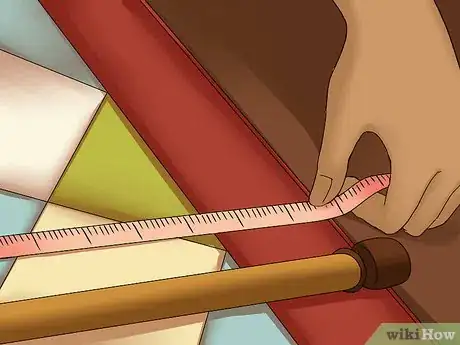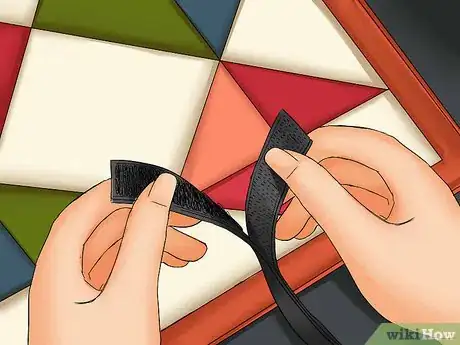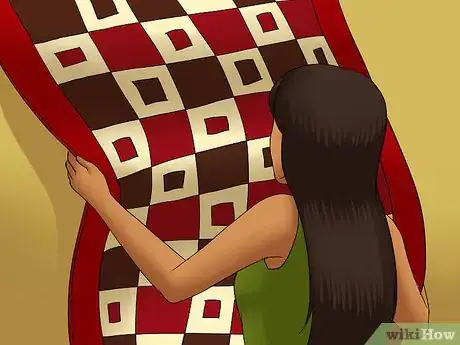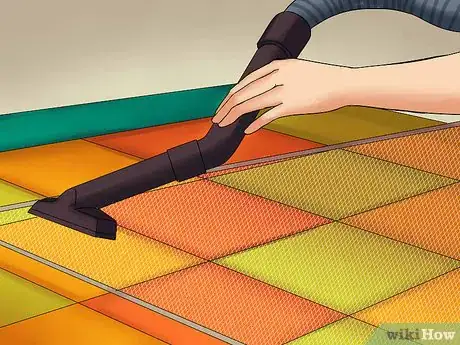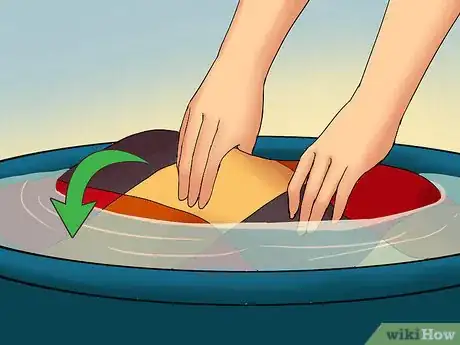This article was co-authored by wikiHow Staff. Our trained team of editors and researchers validate articles for accuracy and comprehensiveness. wikiHow's Content Management Team carefully monitors the work from our editorial staff to ensure that each article is backed by trusted research and meets our high quality standards.
This article has been viewed 28,875 times.
Learn more...
Quilts are not only used for bedding, but for decoration as well. Display your handiwork, treasured heirloom, or prized purchase for all to see by hanging it on the wall! Hang it like a curtain, mount it like a framed picture, or simply use velcro to avoid putting holes in your wall. With thoughtful placement and regular care, your quilt may last even longer than using it as an actual blanket.
Steps
Deciding on a Method for Hanging
-
1Use a hanging rod.[1] Measure your quilt’s width so you can purchase the right sized rod. Then use your measuring tape, a level, and a pencil to mark the wall where you intend to install the rod’s brackets at either end. Screw the brackets firmly into place. Insert the rod through the quilt’s attached sleeve or tabs and then place the rod in the brackets.[2]
- Install a third bracket to support the rod by its center for any quilt over four feet in width.
- When measuring to determine where your brackets will go, mark where the top and bottom of each bracket will be, as well as the screw holes.
- If possible, work with a partner who can stand back at a distance and verify that your markings are level.
- To ease the brackets’ installation, drill a shallow pilot hole for each screw’s marking. Remove the screw and place the bracket against the wall with its screw holes lined up over your pilot holes.
-
2Hang your quilt with velcro. Purchase velcro strips with adhesive backing. Attach two strips to the back of your quilt, one in each top-corner. Then stick more strips at regular intervals along the back’s top for extra support. Next, measure the distance between each strip. Then measure the wall and mark with a pencil where each strip will meet it. Attach corresponding strips on top of each marking and then hang your quilt by pressing the quilt's strips into the wall's.[3]
- Be aware that some wall paint may be resistant to adhesive backings.
- Alternately, screw or nail a wooden board to the wall and attach the velcro strips to that. Choose a board that is 2 inches wide and a half-inch thick. Cut its length to 2 to 4 inches less than the quilt’s width to hide it from view.
- Use more strips than you think you might need to ensure they will hold the quilt’s weight. Line the top at frequent intervals and/or double, triple or quadruple the number of strips used at each interval.
- Strips can be doubly secured to the quilt by hand-sewing or pinning them.
- This method is probably best suited for smaller, lighter quilts.
Advertisement -
3Mount your quilt. Select a wooden framework that is slightly larger than your quilt. Place the framework face-down on top of a slightly larger sheet of washed cotton cloth. Fold the cloth’s ends over the back of the frame and staple them in place so that the cloth is pulled taut over the frame’s face. Next, place the framework face-down on top of the quilt's back and hand-sew the cloth to the back of the quilt. Sew parallel zigzag patterns from top-to-bottom or side-to-side across the entire quilt.
- Hang the frame by its corners with nails or screws, or according to the directions of any hardware that may be included.
- Do not cover the quilt with glass. Blocking air circulation may lead to mold and mildew.
- Use rust-free staples to avoid staining.
Choosing Where to Hang
-
1Pick a spacious area. Obviously, choose a wall with enough area to fit your quilt. Additionally, favor large, spacious rooms to hang larger quilts. Allow viewers to admire them both from far away and right up close.[4]
-
2Make your quilt “pop.” Consider the color or shade of your wall’s paint or wallpaper when searching for a suitable place. Favor those rooms whose colors will contrast those of your quilt. Hang your quilt where it will stand out against its surroundings and catch the viewer’s eye.[5]
-
3Favor artificial lighting. Avoid hanging your quilt where it will come into direct contact with natural sunlight. Prevent it from fading by keeping it out of reach of ultraviolet rays. Use artificial lighting to illuminate your quilt instead.[6]
-
4Avoid environmental extremes. Favor rooms where temperatures are consistently moderate (65-75 degrees F or 18-24 degrees C). Avoid areas with poor air circulation and high humidity, which may lead to mold and mildew. Also avoid hanging your quilt near radiators, ducts for heating or air-conditioning, and other sources of moisture and extreme temperatures. [7]
-
5Hang your quilt out of reach of pets. Make sure the bottom of the quilt hangs high enough to keep it out of harm’s way. Consider both the floor and any furniture that your pets may climb, such as the back of your sofa, your bed or headboard, or shelving. Prevent your quilt from becoming a towel or toy.
Caring for Your Quilt
-
1Give your quilt a rest. Expect the constant pull of a hanging quilt’s weight to damage and weaken its stitching over time. Take your quilt down once every six months to avoid extensive damage. Either alternate it with another quilt for the next six months or hang it back up, only this time upside-down.[8]
-
2Vacuum regularly. Remove dust to preserve your quilt’s fibers. Make sure your floor or table is clean before you spread your quilt on it. Use a handheld vacuum with low-suction to prevent damage to the stitching. Stretch a fiberglass or nylon screen (or even a coffee filter) over the vacuum’s small-brush attachment to further reduce suction. Keep your passes gentle and even as you go. Replace the screen or filter if needed as dust collects.[9] [10]
-
3Soak sparingly. For a deep clean, use a large bedsheet to line a clean bathtub, kiddie pool, or other container large enough to submerge the entire quilt. Place your quilt in on top and then fill the container with a mixture of a half-ounce of mild laundry detergent for every gallon of water. Let the quilt soak undisturbed. Drain the container and press the quilt between your hand and the container to get the soap out. Pat the quilt with a clean towel to remove soapy water. Collect the corners of the bedsheet together and lift the quilt out of the container. Spread the quilt by itself on a clean, non-porous surface and allow it to air-dry.[11]
- Use vacuuming as your primary cleaning method to avoid damaging the quilt through excessive washing.
- Do not soak your quilt if it contains: ink or dyes that may run; glazed, silk, or woolen fabrics; signs of weak stitching or other damage.
- Washing machines, dryers, dry-cleaning, and ironing could all ruin your quilt.
Community Q&A
-
QuestionHow high off the ground and from the ceiling do you hang a quilt?
 Malak ArsalanCommunity AnswerMost wall decorations look best when hung 57 inches off the floor, as this is the average person's eye level.
Malak ArsalanCommunity AnswerMost wall decorations look best when hung 57 inches off the floor, as this is the average person's eye level.
References
- ↑ https://www.amishcountrylanes.com/Pages/Hang.shtml
- ↑ http://www.bobvila.com/articles/how-to-install-curtain-rods/#.V54Z5OsrKVM
- ↑ https://www.amishcountrylanes.com/Pages/Hang.shtml
- ↑ https://www.amishcountrylanes.com/Pages/Hang.shtml
- ↑ https://www.amishcountrylanes.com/Pages/Hang.shtml
- ↑ https://www.amishcountrylanes.com/Pages/Hang.shtml
- ↑ https://www.amishcountrylanes.com/Pages/Hang.shtml
- ↑ http://www.lequilts.com/#!quilt-care-faq/vrk2n
- ↑ http://www.lequilts.com/#!quilt-care-faq/vrk2n
About This Article
To hang a quilt, start by purchasing a hanging rod that's at least as long as your quilt is wide. Then, insert it through the sleeve or tabs on the quilt, and mount it on the wall using brackets. Alternatively, you can attach velcro strips to the wall and the back of your quilt so you can easily hang it up and take it down. Or, you can wrap your quilt around a wooden frame and sew or staple it into place. For advice on how to choose a good spot to hang up your quilt, scroll down!
